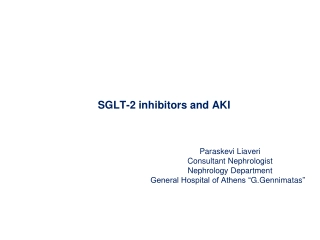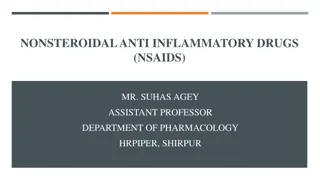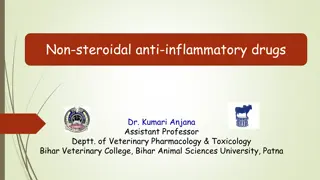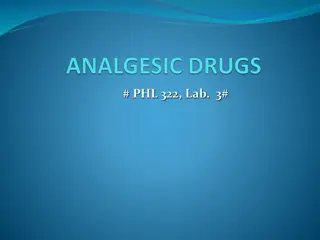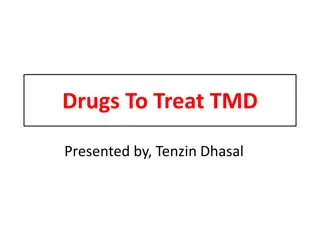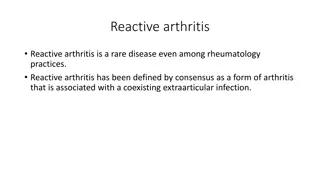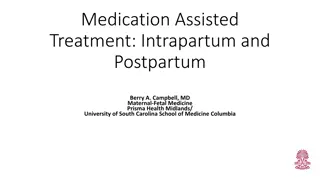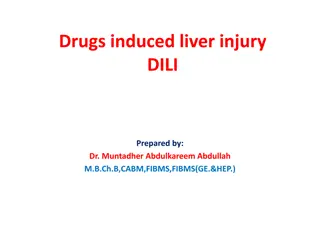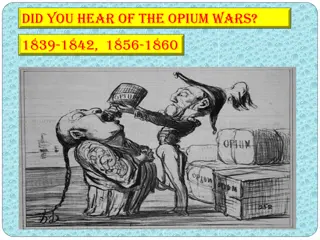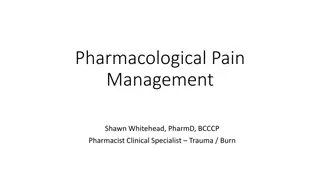Buy Ketof Cough Syrup - silkroadblackpharmacy.com
Buy Ketof Cough Syrup is not suggested for people who are using other NSAIDs (for example, aspirin) or who have advanced renal, cardiac, cerebrovascular, or gastrointestinal illnesses, or who bleed easily. If you have liver, lung, or heart disease, high blood pressure, or inflammatory bowel disease,
2 views • 3 slides
SGLT-2 inhibitors and AKI
Consultant Nephrologist Paraskevi Liaveri discusses the association between SGLT-2 inhibitors and acute kidney injury (AKI). Pharmacovigilance reports highlight a higher risk of AKI with these drugs, especially when combined with RAAS blockers, diuretics, or NSAIDs. Studies suggest potential mechani
0 views • 49 slides
Pharmaceutical Chemistry Analgesic Agents Narcotic Analgesics
Analgesic agents play a crucial role in managing pain, ranging from mild to severe, with different categories such as opioids, NSAIDs, and triptans. The origin of pain can vary from physiological to neuropathic causes. Opioids target opioid receptors, with discoveries in endogenous ligands like enke
4 views • 49 slides
Understanding Nonsteroidal Anti-Inflammatory Drugs (NSAIDs) and Their Pharmacology
Nonsteroidal anti-inflammatory drugs (NSAIDs) are a class of analgesic, antipyretic, and anti-inflammatory medications that work by inhibiting prostaglandin synthesis. They provide relief from pain, reduce fever, and combat inflammation through various mechanisms. Aspirin, a commonly used NSAID, irr
0 views • 21 slides
Understanding Non-Steroidal Anti-Inflammatory Drugs (NSAIDs): Types and Classification
Non-Steroidal Anti-Inflammatory Drugs (NSAIDs) are a diverse group of medications with analgesic, anti-inflammatory, and antipyretic properties. They act primarily on peripheral pain mechanisms and vary in their selectivity of COX inhibition. This article explores the history, classification, and se
3 views • 16 slides
Understanding Peptic Ulcer Disease and Dyspepsia: Causes and Pathogenesis
Peptic ulcer disease and dyspepsia are common gastrointestinal conditions. Dyspepsia presents with upper abdominal pain and may or may not be associated with peptic ulcers. The most prevalent causes of dyspepsia include non-ulcer dyspepsia, GERD, and peptic ulcers. Peptic ulcers account for a signif
0 views • 24 slides
Overview of Non-Steroidal Anti-Inflammatory Drugs (NSAIDs) in Veterinary Pharmacology
Non-steroidal anti-inflammatory drugs (NSAIDs) are a diverse group of medications with analgesic, anti-inflammatory, and antipyretic effects. They act primarily on peripheral pain mechanisms and have limited CNS effects. NSAIDs have a long history dating back to the use of White Willow bark, and the
0 views • 16 slides
Understanding Pain and Analgesics in Medical Science
Pain is a complex sensory and emotional experience linked to tissue damage, with various types of nerve fibers and nociceptors playing key roles in its perception. Pain mediators like bradykinin and prostaglandins modulate sensitivity to pain stimuli. Analgesics, including non-opioid NSAIDs and opio
0 views • 23 slides
Understanding Patellofemoral Pain Syndrome (PFPS) and Its Management
Patellofemoral Pain Syndrome (PFPS) is a common cause of anterior knee pain often related to overuse, malalignment, or trauma. Symptoms include achy pain around the patella, worsened by activities like squatting or running. Diagnosis involves a physical exam to assess patellar mobility and tendernes
0 views • 56 slides
Understanding Non-Opioid Pain Management Strategies
Non-opioid pain management is crucial in the current opioid epidemic, requiring physicians to navigate chronic pain without relying on opioids. This comprehensive approach involves a deep understanding of non-opioid analgesic medications, the nature of pain, anatomy, and physiology of nociception, t
0 views • 36 slides
Understanding Temporomandibular Disorder (TMD) and Treatment Options
Temporomandibular Disorder (TMD) is a condition affecting the jaw joint and muscles, causing pain, limited mobility, and other symptoms. This article delves into the definition of TMD, its causes, symptoms, and pharmacologic treatment options including NSAIDs and muscle relaxants. Learn about the im
0 views • 29 slides
Understanding Reactive Arthritis: Symptoms, Diagnosis, and Treatment
Reactive arthritis, a rare disease associated with infections like Chlamydia, Salmonella, and Yersinia, presents with musculoskeletal features such as oligoarthritis, enthesitis, and dactylitis. Extraarticular manifestations include eye involvement and genitourinary symptoms. Diagnosis involves lab
0 views • 9 slides
Medication-Assisted Treatment in Intrapartum and Postpartum Care
Explore guidelines for medication-assisted treatment during intrapartum and postpartum periods, emphasizing pain management strategies for opioid-dependent patients. Tips include adjusting dosages, adding NSAIDs, and considering opioid agonists with high mu receptor affinity. Careful monitoring and
0 views • 12 slides
Understanding Drug-Induced Liver Injury (DILI)
Drug-induced liver injury (DILI) can present as cholestasis, hepatocyte necrosis, steatosis, vascular damage, and hepatic fibrosis. Various drugs like antibiotics, NSAIDs, recreational drugs, and herbal remedies can cause liver damage. Recognizing DILI is crucial in patients with liver dysfunction o
0 views • 9 slides
Burdizzo Clamp Castration Procedure in Cattle: Advantages, Disadvantages, and Pain Management
The Burdizzo clamp castration procedure involves crushing the spermatic cord to achieve atrophy of the testicles. This method is bloodless, but slow and requires expertise. Proper pain management, including local anesthesia and NSAIDs, is crucial. Regular monitoring and skilled application are neces
0 views • 4 slides
NSAID Use in Chicken Pox: Pediatric Considerations and Implications
This study delves into the debate surrounding administering NSAIDs like ibuprofen to children with chicken pox. It addresses the possible risks associated with NSAID use in varicella infections, focusing on the potential worsening of skin infections due to inhibited neutrophil function. The PICO ana
0 views • 17 slides
The Impact of the Opium Wars and Pain Management Drugs
The Opium Wars were pivotal conflicts between China and Britain due to opium trade. Learn about the devastating effects of opium addiction on China's population. Explore the classes of drugs used in pain management, including NSAIDs and adjuvant drugs, to understand the importance of treating pain a
0 views • 25 slides
Comprehensive Overview of Pharmacological Pain Management Strategies
This comprehensive overview covers various aspects of pharmacological pain management, including behavioral measures for patients unable to self-report pain, building pain regimens, NSAIDs use and associated risks, NSAIDs and COX selectivity, clinical presentation of pain symptoms, gabapentinoids fo
0 views • 22 slides

